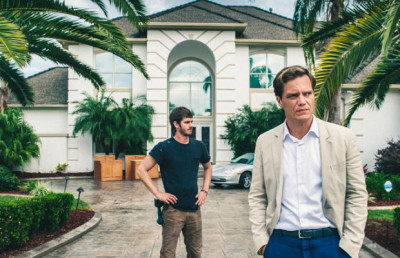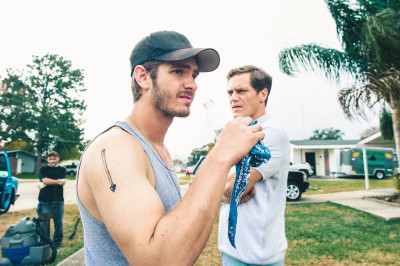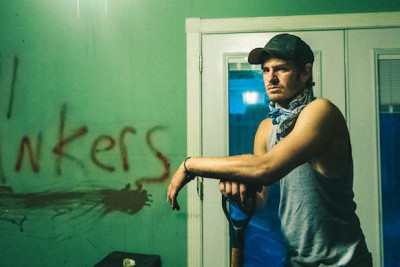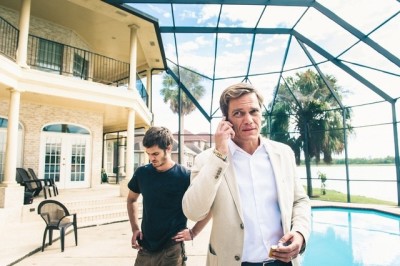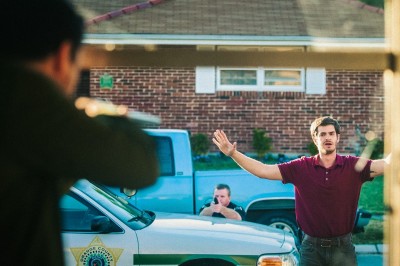As comes as no surprise, writer/director Ramin Bahrani breaks down the door of our collective moral compass with this cat and mouse thriller of corruption versus conscience – 99 HOMES. The very title of the film is enough of a nod to the unending debate over the 99/1 percent nomenclature describing the monetary imbalance in the US today, such that if you know nothing else going into this film, you know thematics will include this economic disparity at its core. With 99 HOMES, Bahrani focuses on the mortgage crisis stemming from the 2008 market crash and “recession”. Of course, as we all well know, the overall housing crisis is a broad topic, but Bahrani hones in one specific area relatable to so many, even today – foreclosure, and the convoluted mess that so many Americans have faced and are still facing.
The Nash family are your typical hard working American family. Dennis and his young son Connor live with their mother Lynn in the family home in Florida. While Lynn works from the home as a hairdresser, construction worker Dennis pounds the pavement looking for any work he can find in the post-2008 depressed economic times. More than 90 days delinquent on mortgage payments, the Nashes are suddenly, and forcibly, evicted from their home by real estate broker Rick Carver. With armed police standing guard, the Nashes are given two minutes to grab personal belongings before Carver sends in a crew to empty the house and all its contents onto the street.
With no immediate relatives to ask for help, the family is forced to stay at local dive motel that rents rooms by the week and by the hour. Much to their surprise, most of the residents at the motel are families just like themselves, families who have had their homes foreclosed on them and the subsequently evicted.
Lynn just wants to move back into the family home. Connor hates that he has to go to a different school. And Dennis, well Dennis knows he has to do something to keep the family together and get their house back. In an unforeseen twist, Dennis goes to Rick Carver, the very man who kicked him out of his home, seeking day labor. It doesn’t take long before that day labor turns into a permanent full-time job for Dennis who works his way up the Carver food chain, becoming Carver’s right hand man and eviction lackey.
Ashamed and afraid, Dennis doesn’t tell Lynn or Connor of his new job, rationalizing his decision as a means to get their home back; he’ll tell them once they are back in their house and they won’t care what he had to do to reclaim it. Initially hesitant in his role kicking people, friends even, from their homes, Dennis is wooed by the money and power Carver wields and promises to him as well. The once hardworking honest Dennis slowly morphs into the same cold, calculating and callous being as Carver. Dennis is blinded by Carver’s success and is led like a lamb to the slaughter by this predatory wolf. But what happens when the truth comes out about what Dennis has been doing. Will Lynn overlook her son’s loss of ethics and morals?
Written and directed by Ramin Bahrani and co-written by Amir Naderi, 99 HOMES puts faces to the stories we have read about and heard about over the past 5 to 7 years, delving into the tip of the iceberg with the fallacies of “the lending system” in this country, but personalizing it. The ambiguity created with the character of Dennis Nash, forces each of us to ask the tough questions – what would you do to save your family, your home; what could you do. Set in 2010, and while for some watching the film it may feel dated, such is not the case as much of the country is still plagued by foreclosures and fallout from 2008; many who lost their homes, have still never recovered. Bahrani develops this story with cat and mouse gamesmanship, hammering home the randomness of the situation – families, seniors, ill and infirm – no one escapes that knock on the door. He sets the stage so that you as an audience member are ever questioning, ever wondering and ever praying that this doesn’t happen to you.
Although the script touches on the confusion of double talking bureaucratic rhetoric with one person telling homeowners don’t worry there will be no foreclosure and then another actually foreclosing, I personally would have liked to see more detail into the legalities of Carver taking properties and the attorneys who promised relief but took money from homeowners when there was no hope of salvation in the immediate situation. Bahrani goes for the emotional structure over the analytical structure, which is more than effective. (This is such a hot button topic that either storytelling approach would prove successful.) Interesting is that despite the homeowner horrors unfolding, Bahrani offers hope for recovery, but by way of commentary on the country’s social injustices of the haves and the have nots, it bears the idea that someone will always be the loser. Unfortunately, to dig deeper, Bahrani would have had a four hour film. While 99 HOMES is a cohesive work throughout, there is, however, somewhat of a disconnect at film’s end that makes one wonder if Bahrani, who did his own editing, left something on the cutting room floor earlier in the film that would clarify the ultimate conclusion.
When it comes to performances, as Rick Carver, Michael Shannon is hypnotic. A force of nature, he leaves an oil slick in his wake that is delicious and has you begging for more. You are riveted to every frame he is in and hang on every word he utters and every glare he throws at you. Because Shannon is such a powerhouse with complete immersion and resonance, disappointing is that we don’t learn a bit more about Carver’s story and his driving forces.
Andrew Garfield, on the other hand, is a little uneven with his take on Dennis Nash, never quite selling the “survival” aspect of working for Rick and all the money Dennis is making or the intelligent observations he makes about pulling some cons of his own. Doesn’t fit the scruffy unkempt and seemingly under-educated character which appears due to some uneven dialogue. But put Shannon and Garfield together and there is undeniable electricity and that’s where 99 HOMES soars.
As Bahrani related to me, “[Andrew] wanted to be loose and be able to improvise. . . Michael is a different kind of actor and wants something different from me. That was an interesting challenge because I had two amazing actors who respected each other deeply and who had radically different approaches to performance. My job became letting both of them happen at the same time because both those actors have to do what they want to do. . .That created what you see in the film which is spark, energy, electricity. It was so obvious from the first time they got on a scene together in the shoot. You’re watching two great actors go toe-to-toe, scene after scene after scene, butt heads, and bond a little bit and then spark of mistrust or someone pull a knife on someone or yell or fight, whatever they’re gonna do. Part of that’s the script. Part of that’s their characters. Part of that’s their different acting styles, butting up against one another. To me it was just amazing to watch.”
And then there’s Laura Dern who grounds the film and maintains the moral compass. She is ideally cast. With his take on Connor Nash, Noah Lomax breaks your heart. There is nothing worse than seeing the entire world of a child be stripped from him. Lomax will have you reaching for the tissues as he indelibly captures the pain, the sorrow, the fear of a 10-year old. Be on the lookout for a nice turn by Clancy Brown in a very corporate turn as Mr. Freeman
Visually, 99 HOMES is a metaphoric stunner. Because this a very emotional story and the thematics are very defined, there’s also great ambiguity and we look to that visual tone for either clarity or deliberate obfuscation. Cinematographer Bobby Bukowski tells a visual story with light and lensing that at times is more powerful than the dialogue unfolding. With the evictions, camera work is hand held, jerky, intense close-ups, 360 degrees. In designing the visuals, Bahrani and Bukowski worked closely together to achieve the right emotional resonance with visuals. “I remember we sat down and went through all the scenes and we were like, ‘What’s our intuition say here? Hand held steadicam or studio mode for shooting?’” We are put in the unsettling and frightening situation with the displaced homeowner. Lighting is key, particularly with Shannon’s Carver. Bright, bright, white light – as if blinding everyone with the light to obfuscate the truth behind the fast talking facade. Concurrently, camera goes wider, slicker, giving the illusion of a king overseeing his kingdom. Intimate, warmer light is in the Nash home and in the hotel room. Alex DiGerlando’s production design comes into play on every level; particularly within the Nash home as we feel the lived in, familial qualities with the paneling and golden tone of the light. Lighting is all natural. Camera is static in the home, slower movements, observational. Slower energy. In the motel room, we feel the claustrophobia but the lighting opens up and lightens the emotion, providing a tonal continuity for the grounding of Dern’s performance. Waterfront exteriors are serene, picturesque, completing the facade of Rick and his empire.
The omnipresent percussive scoring of Anthony Partos and Matteo Zingales sets its own tone for the film, but it’s one that never changes. In contrast to the visuals, production design and performances which have immersive peaks and valleys and emotional fluidity, the score plays like a throbbing migraine that underscores any hopefulness for recovery.
The reality of 99 HOMES should be frightening to us all. Most of us are the 99%. Our homes are the 99 homes. Could you be the next Dennis Nash? The game is afoot asking each of us “Just how far would you go to save your family?”
Directed by Ramin Bahrani
Written by Ramin Bahrani and Amir Naderi with story by Bahrani and Bahareh Azimi
Cast: Michael Shannon, Andrew Garfield, Laura Dern, Clancy Brown

